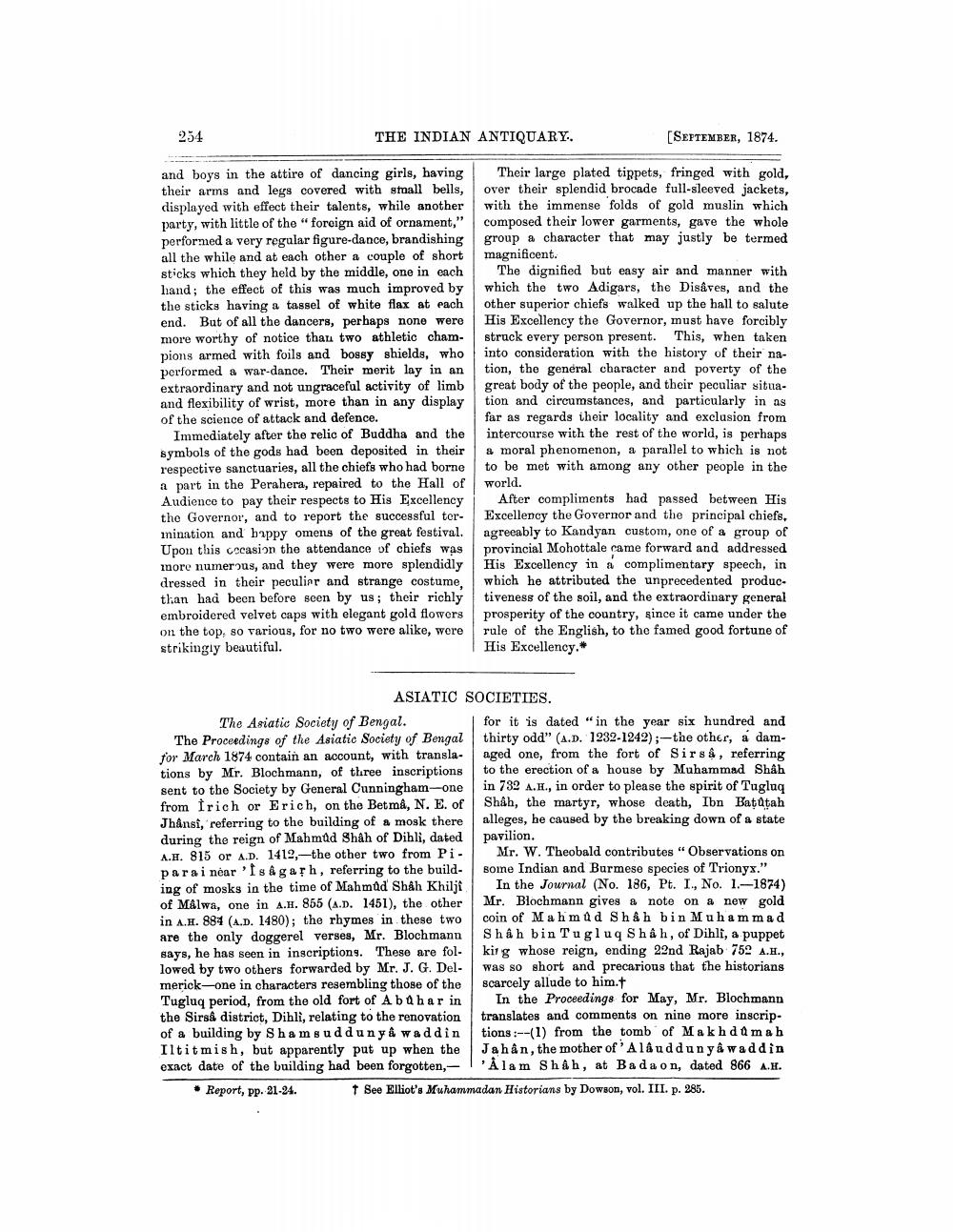________________
254
THE INDIAN ANTIQUARY..
[SEPTEMBER, 1874.
and boys in the attire of dancing girls, having their arms and legs covered with shall bells, displayed with effect their talents, while another party, with little of the foreign aid of ornament," performed a very regular figure-dance, brandishing all the while and at each other a couple of short sticks which they held by the middle, one in each land; the effect of this was much improved by the sticks having a tassel of white flax at each end. But of all the dancers, perhaps none were more worthy of notice than two athletic champions armed with foils and bossy shields, who performed a war-dance. Their merit lay in an extraordinary and not ungraceful activity of limb and flexibility of wrist, more than in any display of the science of attack and defence.
Immediately after the relic of Buddha and the symbols of the gods had been deposited in their respective sanctuaries, all the chiefs who had borne a part in the Perahera, repaired to the Hall of Audience to pay their respects to His Excellency the Governor, and to report the successful termination and happy omens of the great festival. Upon this cecasion the attendance of chiefs was more numerous, and they were more splendidly dressed in their peculiar and strange costume, than had been before seen by us; their richly embroidered velvet caps with elegant gold flowers on the top, so various, for no two were alike, were strikingly beautiful.
Their large plated tippets, fringed with gold, over their splendid brocade full-sleeved jackets, with the immense folds of gold muslin which composed their lower garments, gave the whole group a character that may justly be termed magnificent.
The dignified but easy air and manner with which the two Adigars, the Disaves, and the other superior chiefs walked up the hall to salute His Excellency the Governor, must have forcibly struck every person present. This, when taken into consideration with the history of their nation, the general character and poverty of the great body of the people, and their peculiar situation and circumstances, and particularly in as far as regards iheir locality and exclusion from intercourse with the rest of the world, is perhaps & moral phenomenon, a parallel to which is not to be met with among any other people in the world.
After compliments had passed between His Excellency the Governor and the principal chiefs, agreeably to Kandyan custom, one of a group of provincial Mohottale came forward and addressed His Excellency in a complimentary speech, in which he attributed the unprecedented productiveness of the soil, and the extraordinary general prosperity of the country, since it came under the rule of the English, to the famed good fortune of His Excellency.
ASIATIC SOCIETIES. The Asiatic Society of Bengal.
for it is dated "in the year six hundred and The Proceedings of the Asiatic Society of Bengal thirty odd" (A.D. 1232-1242);-the other, a damfor March 1874 contain an account, with transla- aged one, from the fort of Sirsa, referring tions by Mr. Blochmann, of three inscriptions to the erection of a house by Muhammad Shah sent to the Society by General Cunningham-one in 732 A..., in order to please the spirit of Tugluq from Irich or Erich, on the Betma, N. E. of Shah, the martyr, whose death, Ibn Batatah Jhânsi, referring to the building of a mosk there alleges, he caused by the breaking down of a state during the reign of Mahmud Shah of Dihli, dated pavilion. A.H. 815 or A.D. 1412,--the other two from Pi. Mr. W. Theobald contributes" Observations on para i near 'Isagarh, referring to the build- some Indian and Burmese species of Trionys." ing of mosks in the time of Mahmud Shah Khilji In the Journal (No. 186, Pt. I, No. 1.-1874) of Malwa, one in A.H. 855 (A.D. 1451), the other Mr. Blochmann gives a note on a new gold in A... 884 (A.D. 1480); the rhymes in these two coin of Mahmud Shah bin Muhammad are the only doggerel verses, Mr. Blochmann Shah bin Tugluq Shah, of Dihli, a puppet says, he has seen in inscription. These are fol- kirg whose reign, ending 22nd Rajab 752 A.H., lowed by two others forwarded by Mr. J. G. Del- was so short and precarious that the historians merick-one in characters resembling those of the scarcely allude to him. Tugluq period, from the old fort of Abohar in In the Proceedings for May, Mr. Blochmann the Sirsê district, Dihli, relating to the renovation translates and comments on nine more inscripof a building by Shamsuddunya waddin tions:--(1) from the tomb of Makhda mah Iltit mish, but apparently put up when the Jahân, the mother of 'Alauddun yawaddin exact date of the building had been forgotten,- l'Alam Shah, at Bada on, dated 866 A.H.
• Report, pp. 21-24. See Elliot's Muhammadan Historians by Dowson, vol. III. p. 285.




